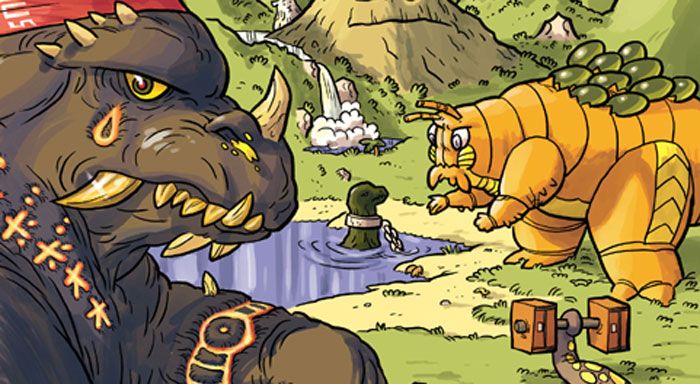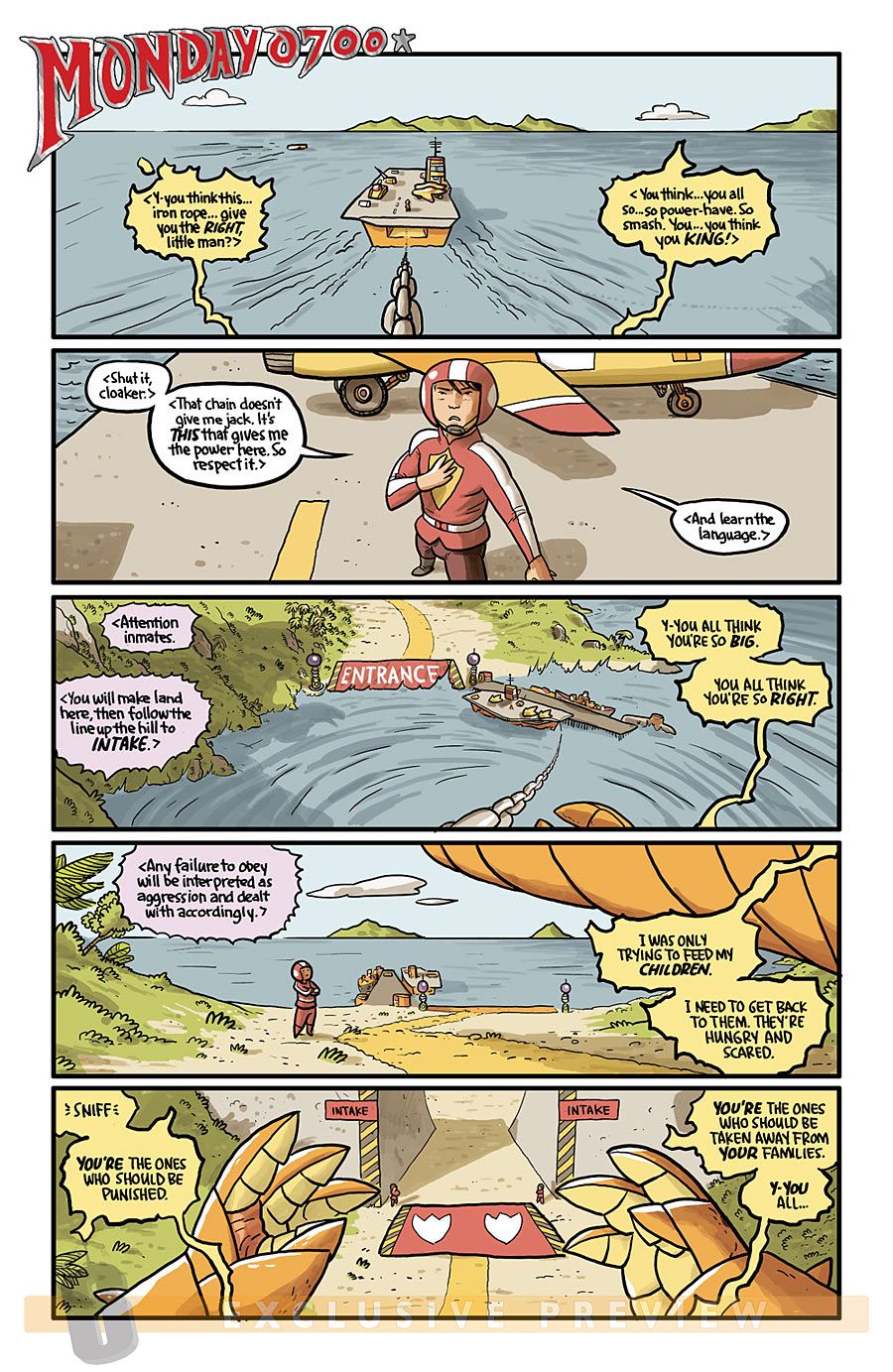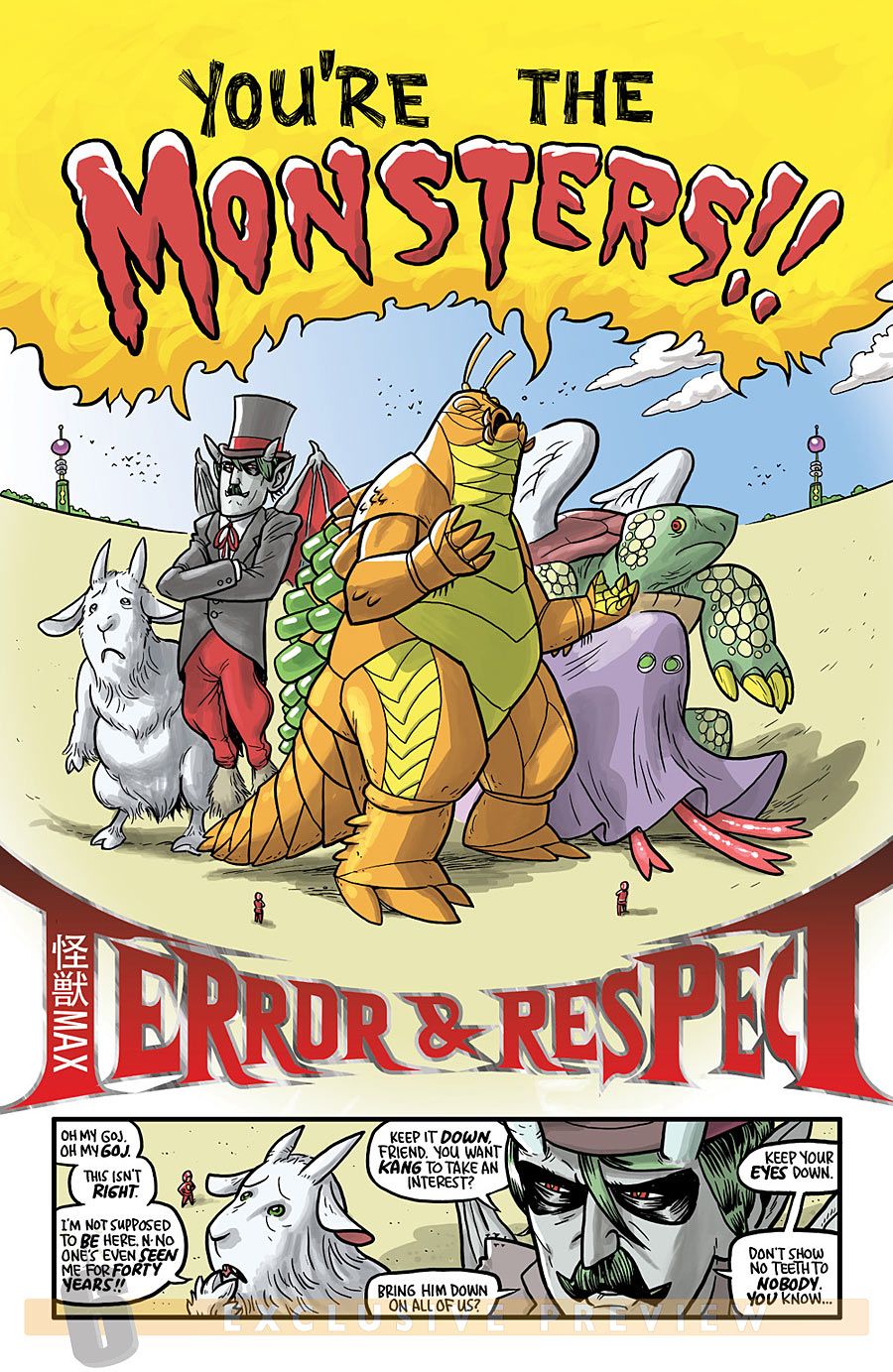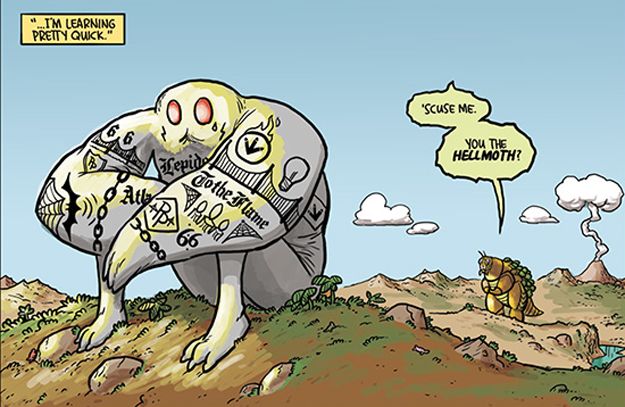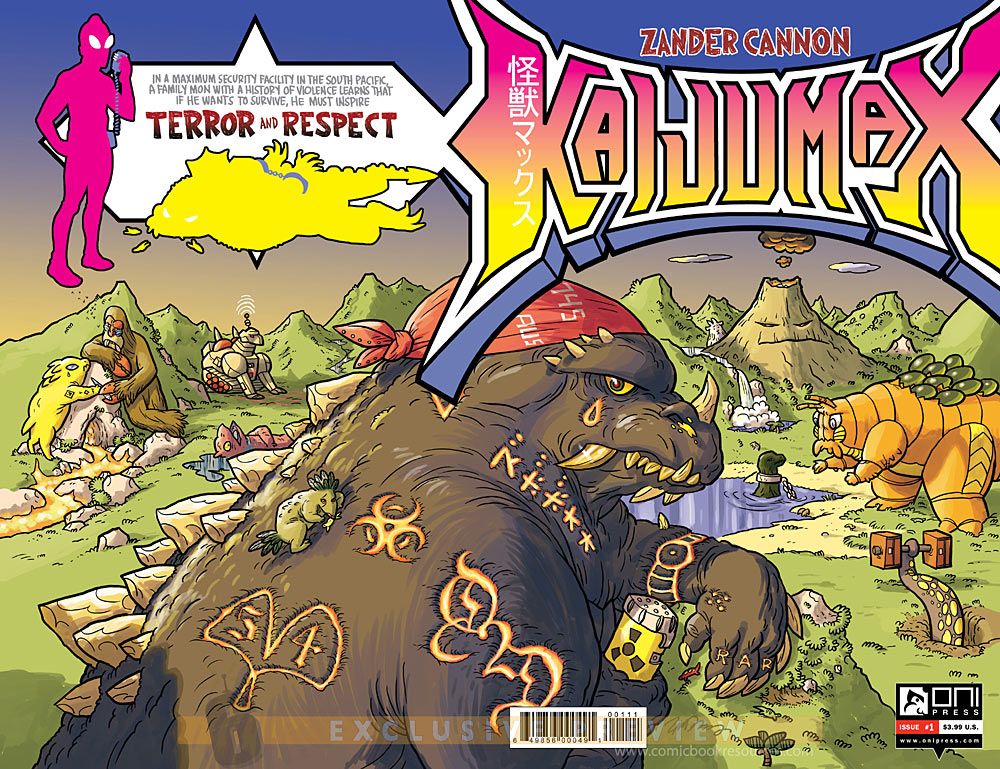After sending his hero into the underworld in the acclaimed 2013 graphic novel Heck, for his next project cartoonist Zander Cannon is sticking his characters in a different kind of hell: a maximum-security prison for giant monsters.
Debuting in April from Oni Press, Kaijumax follows Electrogor, a new inmate at the titular island facility in the South Pacific who only wants to get back to his hungry and frightened children. Standing in his way are Ultraman-like guards, led by the fearsome warden Kang, and some of the biggest, baddest monsters of legend and popular culture.
Cannon spoke with ROBOT 6 the inspiration for the ongoing series, grounding the outlandish premise with a surprisingly straight-laced tone, and coming up with kaiju slang.
ROBOT 6: Tell me a little about the origins of Kaijumax. Toho’s Destroy All Monsters has to have played some role in its birth.
Zander Cannon: Totally. The idea of a 'Monster Island' was always an appealing one to me. Alan Moore made reference to it in one of the issues Top Ten that Gene Ha [did], and gave it a feeling of more of a big hangout for monsters. I liked that idea, and that general idea had been kicking around in my head for a long time. The thing that started to put it in place was that, a while after we adopted our son from South Korea, I ran across a DVD set for Ultraman in a store, and I thought it would be nice for him to have a kid's show to watch that had an Asian hero. Little did I know how much he would love it -- he and I would even give each other the “forearm zap” when I dropped him off at daycare -- and in the course of me and my wife watching many, many episodes with him, I got sucked into the big-monster genre.
A little later, Ryan Browne and I had been trying to figure out something that we could work on together that he would draw and I would write. I was thinking about something that would play to his strengths -- over-the-top monster designs, crazy violence -- and I thought of my monster island, and then added the idea of Ultraman guards, making it a prison, and then crammed all that into a borderline-exploitation formula halfway between HBO's Oz and Escape from Alcatraz. Ryan did some great art, and we were working to get it going, but his star was rising, and he got a great Kickstarter going for God Hates Astronauts and then got that going as a series, and far be it from me to stand in the way of someone's dream project. So the series was kind of nowhere for a while, until Charlie [Chu] and James [Lucas Jones] at Oni asked if I might want to draw it myself, and -- although my first response was “God, no, that sounds like a nightmare” -- the rest is history.
For such an outlandish premise – a maximum-security prison for giant monsters – you play things relatively straight; a lot of the dialogue would be right at home in a prison movie. How difficult was it to settle on the right tone?
It is tricky. I like outlandish premises, and I love kind of “list stories,” where you come up with a fun central premise and then basically list all the funny stuff that would necessarily come out of it, but I feel like jokes only get you so far. This book owes a lot to Top Ten, and its clear devotion to the flow of its storytelling conceit -- police procedurals -- which was then peopled by the stock characters of its (for lack of a better term) mood conceit -- superheroes. At its best, that book felt very workaday, mundane and serious, and it was the mismatch of the superhero stuff that made it funny. In Kaijumax's case, prison movies are the template, and those stories are all either downbeat or lurid, or both, so I liked the idea that it would all be played pretty straight along those lines, with the monster gags providing an odd tone, making scenes simultaneously tragic, funny, and disgusting (my personal favorite trifecta).
I also think, like all good SF and fantasy, you can get a lot of mileage out of exploring concepts and personalities when they are in an unfamiliar package. I mean, first and foremost I want to deliver an enjoyable story with lots of jokes and fun characters and good lines, but any story about prison starts to involve ideas about being unwanted by society, or addiction, or anger, or betraying your principles, etc., and I think that's where you find the real heart of the story.
A few of the characters are clearly inspired by some iconic monsters (there’s even a nod to Koopa Troopas, if I’m not mistaken), but most appear to be wholly original. How much fun is it creating these crazy-looking kaiju? Are you finding yourself always trying to top the previous one?
I kind of have a funny way of designing monsters. For a while, I was really trying to come up with unique ones, and really sitting down and designing them before I put them in, but all of the monsters in the story are supposed to basically stand in for a type of monster or a type of monster movie. What I do now is just basically look up a bunch of pictures of the type of monster I'm looking for and then just copy them badly -- by which I mean I just grab bits here and there without trying to be accurate, and new monsters just emerge out of that. They end up having a lot more life than my "real" designs. The funny thing about that, too, is that as soon as I draw them, say as background characters, I start involuntarily giving them personality, and then they become main characters, just on the strength of having a cool-looking horn or something.
We’re introduced to Kaijumax through Electrogor, who’s brought to the island in the opening page and spends the rest of the issue trying to get back to his children. Is Kaijumax his story, or will you bring other characters into the spotlight?
It's meant to be very much an ensemble piece, though Electrogor is your typical viewpoint character: relatable, doesn't know much about the prison, etc. The first arc is heavy on his story, but it's stretched out a fair bit so we can follow the other characters, good and bad. I feel like every character has a goal, and I like that we can even get involved in the bad guys' arcs; the moral relativism is a big part of what's interesting to me about prison drama.
There will be a lot of alliances, betrayals, plots, conspiracies, seductions, violence, and characters going “stir crazy” (or Mon-stir crazy, as it were), and there will always be more characters coming to the forefront as others fade away. Or are horribly murdered.
As much as I like Electrogor, I have to say my favorite is the Mothman-esque Hellmoth, whose prison tattoos are inspired: “PP” for Point Pleasant, “66,” the Silver Bridge ... I hope we haven’t seen the last him, if only so we can be exposed to more of his tattoos and philosophizing.
That's awesome that you noticed those. I hate myself when I sketch something, like tattoos, as little scribbles, and then get to the day when they have to be something and I realize that they really ought to be something clever, so I spend half a day just doing little gags in one corner of one panel.
It's kind of funny, since this issue was written as a script for Ryan, and I actually wrote in the panel description that he should just go nuts designing the tattoos and making them really detailed, since the character would never, ever show up again. But of course, a few friends who have read it have told me that's their favorite character, so who knows?
The philosophy was meant to mirror the philosophy or rejecting one's “slave name” and using something more in line with your origin. Although the rejection of it is was big with the Nation of Islam, and that is more directly represented by the mecha creatures in Kaijumax, I wanted to make sure that the parallels weren't too direct, so you'll find a lot of crossover in the issues that they find important.
Warden Kang looms large (literally) over Kaijumax, to the point where he’s effectively the monsters’ own boogeyman. He’s presumably based on the likes of Ultraman, but what can you reveal about the character and his creation?
Well, he's certainly based on Ultraman, and I wanted to give a sense that the classic Ultraman would probably be pretty terrifying to all the monster's he's beaten, dismembered and killed, so he would make a perfect cruel warden-type. I've always liked the name “Kang” as well, going back to Kang the Conqueror in the Marvel Universe, but the fact that it's also a Korean name made me think about what I wanted for the human cast. There's not meant to be much backstory or mythology here -- I'd rather have the conceptual jokes and the character business drive the plots rather than the other way around -- but I wanted to have a sort of Pan-Asian collective running the prison. Kang and Jeong are Korean, there are several Japanese, Chinese and Vietnamese names, and there's the corrupt guard Gupta, who's Indian. The implication, too, is that they all have the same ability to turn into Ultra-type guards when things get serious.
Kaijumax was announced at New York Comic Con as an ongoing series. How far out to do you have the story plotted? Do you know about how many issues it will be?
I'm planning it as five six-issue “seasons” that each wrap up big arcs and have a number of smaller subplots running throughout. I feel like there's always a certain expiration date on these sort of conceptual mashups, so I want to make sure it's good and clever and fresh all the way through, and then wrap it up with a bow.
You earned widespread acclaim in 2013 with Heck, which was serialized on Double Barrel and then collected into a graphic novel. What made you decide to return with the monthly printed format with Kaijumax?
I really enjoy that format that I did Heck in, and I was hard at work on another book that had a similar visual approach. But to be honest, those sorts of books don't serialize as well as I'd like, and consequently don't make a great deal of money until they come out as a collection at long last. Heck was great fun, but I did it in my spare time over five years while I did every other thing that crossed my desk. When Oni told me they could make this my primary job and I could work on my own creator-owned book as a No. 1 priority, well, you just don't turn that sort of thing down. It's nice that a little bit of critical attention can tip the scales ever so slightly and make a thing like that possible. Creatively, I enjoy the change of thinking about this story in shorter chunks; creating a world out of 22-page ensemble stories rather than constantly building, building, building to a massive climax. There's all of that, too, but it's fun to allow the story to explore more subplots in detail in this episodic format.
I have to know the story behind the monsters’ exclamation of “Oh my Goj!”
Goj for Gojira, the original Japanese pronunciation of Godzilla. I wanted to have nods to classic monsters, but treat them almost as if they were folklore, or religion, not as if they were peers. I also like creating slang that implies a shared subculture, and in which the things that the creatures say reveal something about the way they think. Referring to humans as “squishers,” cursing each other out as “megafauna,” calling their friends “my lizza'” etc. Like you said, a lot of the dialogue is played pretty straight, so things like that give the classic prison lines a little bit of monster-style zing. My personal favorite is “cloaker,” which is meant to be a lazy corruption of “cloaca” -- the all-purpose lizard butthole that they all have. And if that isn't a great note to end this interview with, I don't know what is!

